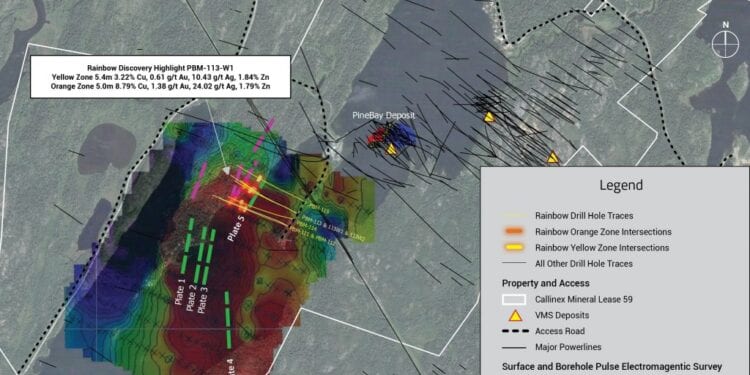New Targets Located Along Strike From Rainbow Discovery
Callinex Mines Inc. (TSXV: CNX) is fast-tracking plans to drill four new targets identified from a 10 line km deep penetrating surface pulse electromagnetic survey (SPEM) completed at at the 100% owned Pine Bay Project located in the Flin Flon Mining District of Manitoba.
The four highly conductive anomalies each have a strike extent of 300m and are on strike from the company’s recent Rainbow Discovery.
The Rainbow Discovery has been made on Callinex’s mineral lease, less than 250m from a high-voltage power-line and 550m from a historic shaft with direct road access to processing facilities in Flin Flon, MB.
Callinex’s technical team, working in conjunction with Koop Geotechnical Services Inc. has identified the four highly conductive anomalies located near-surface and along strike to the south of the Orange and Yellow zones of the Rainbow Discovery.
The Survey was completed based on the success to date of the Rainbow Discovery and the area to the south had not previously been covered by any deep penetrating electromagnetic system.
Callinex Founder, Mike Muzylowski, said the identified anomalies expand the strike extent of the Rainbow over 1 km to the south. The three major base metal mines discovered in the Flin Flon/Snow Lake Greenstone Belt with tonnages ranging between 25 – 70 million tonnes (Flin Flon/777, Trout Lake, Chisel/Lalor) have a strike length over 1 km.
Based on the recent survey, the Rainbow Discovery has a strike length of at least a kilometre with potential to grow further along strike to the south.
“We acquired the Pine Bay Project because it encompasses one of the largest altered felsic volcanic rock packages that I’ve come across and with it the potential to host a significant deposit,” Mr Muzylowski said.
“I believe, based on the high-grade mineralization intersected to date coupled with the targets outlined by our team today, that the Rainbow Discovery may become one of the more significant discoveries I’ve been a part of in my career exploring the Flin Flon Greenstone Belt.”
Each of the four modelled conductive anomalies (Anomalies 1-4) have a strike extent of 300m and are interpreted to begin at a vertical depth of 200m. While none of these plates have been tested by diamond drilling, some historical holes in the vicinity have intersected alteration and geology as seen in recent Rainbow zone drilling. Anomaly 5, which is the modeled conductive body of the Orange and Yellow zones, has a modelled strike extent of 150m, or half the length of Anomalies 1-4.
Mr Muzylowski said it should be noted that deposits in the Flin Flon Greenstone Belt typically have a plunge extent on average between 5-8 times the strike of the deposit. Additionally, all larger producing Volcanogenic Massive Sulphide (VMS) mines are made up of a number of stacked zones or lenses such as the Orange and Yellow zones discovered to date at the Rainbow.
Drilling results
Callinex received results from three additional drill holes mark the end of the company’s 2020 drilling campaign.
Drill Hole PBM-113-W2 intersected the Rainbow Horizon 225 metres vertically above the PBM-111 discovery hole which demonstrates that mineralisation will continue to be defined closer to the surface. Correlation between its parent hole PBM-113 which is 100 metres vertically below PBM-113-W2 is supported by the intersection of the Orange Zone which returned 5.7m of 4.72% copper equivalent (CuEq) comprising of 3.57% copper, 0.54 g/t gold, 21.41 g/t silver and 1.56% zinc.
PBM-114 tested the Rainbow Horizon 150 metres below hole PBM-112 in an effort to better define the southern edges (plunge) of the Yellow and Orange zones. Narrow widths associated with the Yellow and Orange zones in PBM-114 suggests future drilling needs to trace northerly from this location.
PBM-115 was designed to test the northern strike extent of the Orange and Yellow zones and represents a 75 metre step out from PBM-113-W1. PBM-115 intersected the Yellow Zone 783 metres down hole and intersected 3.13m of 1.95% CuEq consisting of 1.45% copper, 0.20 g/t gold, 6.76 g/t silver and 0.82% zinc.
Plans are underway to immediately initiate a drilling campaign to test the four conductive bodies in tandem with continued drilling to define the Orange and Yellow zones.












